Theory of Corresponding Squares
Endgame theory consists of various concepts. Unlike opening, the theory in the endgame is not getting influenced by the computer. Knowing certain concepts will always help to understand various endgame theories. Correspondence squares is one of those must-know concepts. Is it only limited to pawn endgame? GM Sundararajan Kidambi explores the concept which he found quite complex since his childhood. Chess journalist, Thorstein Cmiel shared a position with him from this year's European individual championship. It piqued Kidambi's interest into the topic. Check out the detailed analysis by Kidambi and enrich your endgame knowledge. Photo: Shahid Ahmed
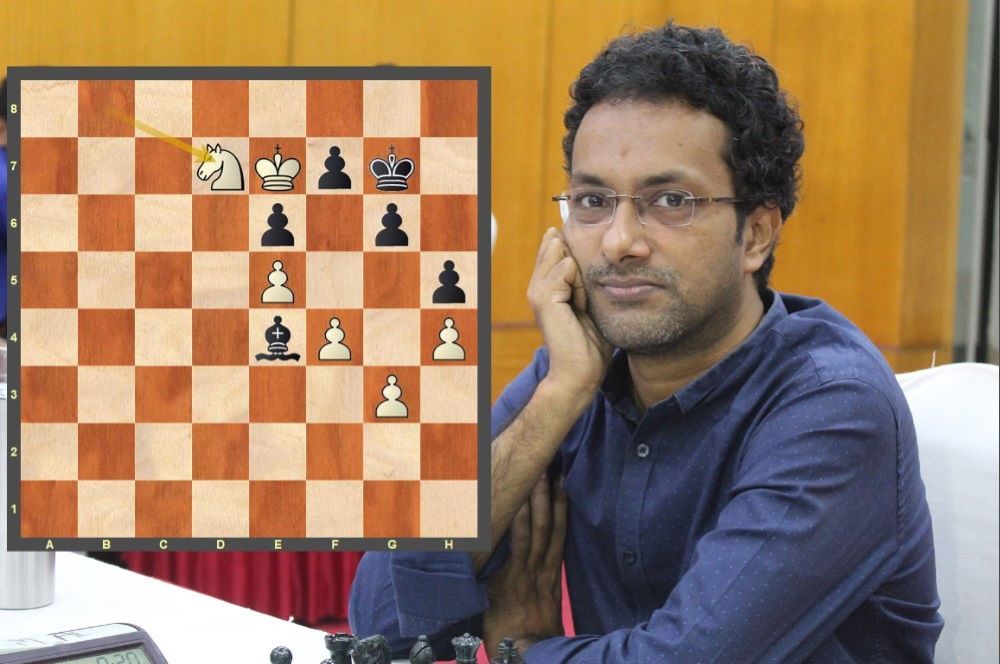

In Endgame theory, especially in king and pawn endgames there is a concept known as Corresponding Squares (Sister Squares as mentioned by some Russian authors) which always seemed as quite a complex part of the endgame for me since my childhood. My memory vaguely wanders around some books by Jonathan Speelman and Averbakh. Personally, I have never had this concept in any of my endgames. I also, do not recall having even seen them in recent praxis. Of course, Dvoretsky and Mueller have also dealt with this topic in their own endgame manuals in a very detailed manner.
In a recent game of Rasmus Svane, I happened to notice an endgame with four pawns for each side and his opponent having the better minor piece and a better placed King. My friend Thorsten Cmiel had shared the following position with a comment that it needed to be solved by the system of corresponding squares.
Kourkolos - Svane, Eu Ch 2023

This is the position from the abovementioned game after White's 56th move. I wanted to take a look at this position and try to understand if it indeed had to be solved by the process of corresponding squares. A very basic look at the position gives a thought that this position ought to be won for White as the knight would sooner or later win the f7-pawn and with it the game! Pawns being on a single flank and fixed on the same coloured squares as their own bishop for Black seem to be a clear disadvantage. Black has complete lack of control of dark squares, and would not this mean that White would simply get his knight to either d6 or d8 and finish the game off?
Looking a little further we see the Black's only chance to save the game (if indeed there is) is to use the long-range bishop's power to stop White's knight from the reaching the squares from which it can attack Black's weakest spot on f7. Let us work backward on how this can be achieved. It is clear that the Bishop cannot control the dark squares namely g5,d6 and d8 from where the White's Knight can win out pawn on f7. So, logically the bishop should prevent the knight from reaching those dark sqaures by controlling the light squares from which the knight can reach those key squares. This leads us to identifying the key squares that need to be controlled as follows:
e8, c8, b7, b5, c4, e4, f3, h3
If the bishop can take care of these squares and stop White's knight from reaching them, it is safe to say that Black will manage not to lose the game. So is this knowledge enough to make a draw in this position? Let us see the further course of the game.
56...Bb7! 57.Nb6 Ba6! 58.Na4
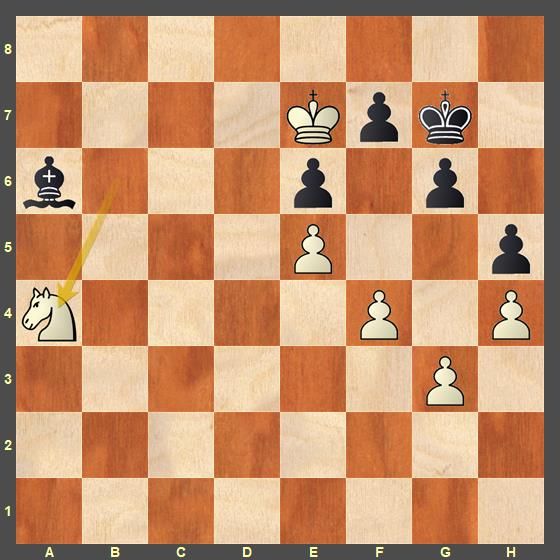
This is the position that was shared by Thorsten, and it was here that Black had gone wrong and went on to lose the game. Let us see how the game continued
58...Bb5? 59.Nc5! Bc6 60.Nb3 Be4 61.Nd4 +-
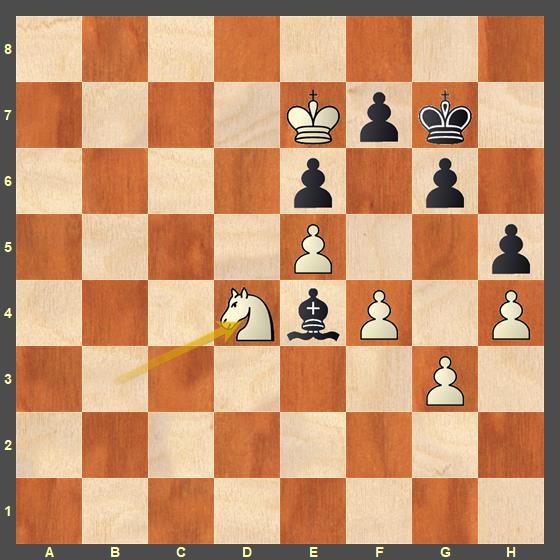
Here we see that Black cannot stop White's knight from reaching the key squares from where the f7-pawn can be attacked. So Black resorted to desperation with
61...g5 but White went on to win the game after 62. fxg5 Bd3 63. Nc6 Bc2 64. Nd8 Bg6 65. Nb7 Be4 66. Nd6 Bg6 67. Ne8+ Kg8 68. Kf6 Kf8 69.Ng7 1-0
Black resigned as he loses another pawn. Taking a look at the last diagram we see that the d4 square is an incredible one for White's Knight. From here he is threatening to jump to c6, b5 and f3 and Black's Bishop has no square on the board from where it can stop all these three jumps.
This leads us to understand that White's knight must be absolutely stopped from reaching d4 at any cost in order to save the game. This means that we should not let the knight reach b3, c2 and e2 as well!
Given this understanding, going back to the 58th move, we see that Black had to play
58...Bc4! as he has to meet 59.Nc5 with Bd5 (from this square Black controls both the key squares b7 and b3 and thus holds fort)
Coming back to our topic of corresponding squares, they are squares which our pieces have to be (in this case our bishop) corresponding to the opponent's (in this case the knight) at a given time. From the given example we see the corresponding to c5 for White's knight, Black's bishop has to be on d5. So this is a corresponding square. No other square on the board would help black save the game! By thinking further, we come to the following set of corresponding squares:
White knight : Black bishop
1. d7 : b7
2. b6 : a6
3. c5 : d5
4. c3 : d3
5. d3 : f3
6. f2 : f5, g2
7.c1 : d1
8. a2 : c2
There could be further correspondence squares, but as far as I mapped out these seem to be enough. Based on the above chart, I also give a sample line. In fact, the chart was worked out from moving pieces around and is given in retrospection!
58...Bc4! 59.Nc3 Bd3! 60.Nd1 (60.Na2 Bc2!) 60...Bf1 61.Nf2 Bg2! 62.Nd3 Bf3! 63.Nc5 Bd5! and we are back to a position that was already analysed.
By practical application in this position, I could understand the concept of corresponding squares a little bit better. It is actually working things in reverse. This is a key idea in composing Chess Studies, as my friend Grandmaster Sandipan, who being a very inventive composer, can no doubt vouch to. Since I do not have any personal experience in composing studies, I could relate this to composing a poem, particularly in Venba metre (a form of Tamil Poetry) where each word needs to be in correspondence or relation with the next and previous one and many a time the composition of poetry goes in reverse like the fourth line of the poem and then going backward with the third line and so on!
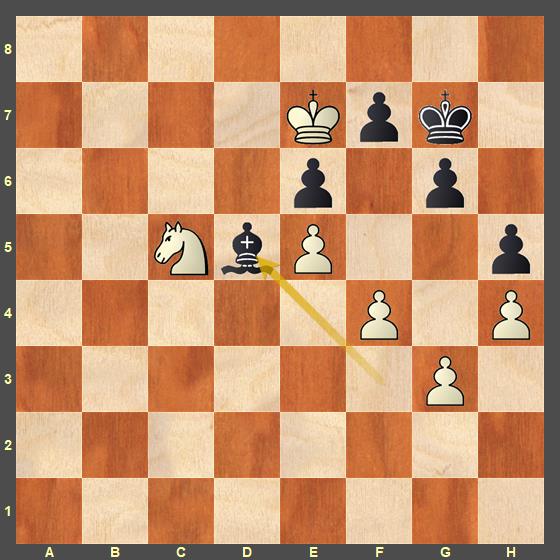
In order to understand this endgame better, I tried to see what happens if it were Black to move here. We have established that the bishop cannot move and so it needs to be seen as what happens after a move such as
1...Kg8!? White wins after 2.Nd7! Bb7 3. Nf6+ idea Ne8 and the knight reaches d6 and wins the game.
or if 2...Bc6 3.Nb6! wins for White as Black is not able to reach the corresponding square a6 on time with his bishop.
This shows that the corresponding squares are also positions of mutual zugzwang and Black does not have any extra moves with his king!
Hey, 1913

The above position is a composition by Hey taken from Averbakh's monumental comprehensive Chess Endgames. Black is needs to defend both the-a5 pawn and also against White's Knight reaching f7.
Bondarenko, 1946
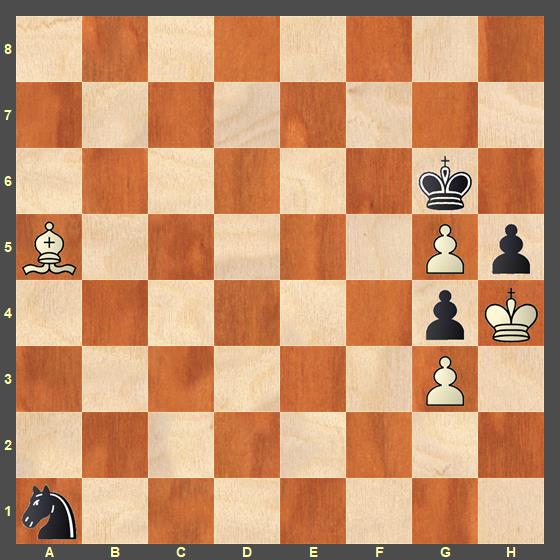
This position is a composition of Bondarenko and a more complex one compared to the previous position. But White still draws the game with right play. I urge the readers to analyse these positions and check for themselves how this is so. I have given the solution in the replayer below which contains all three positions with their varied lines.
I forgot to mention the important principle that came to mind while studying these endgames, it reminded me of the knight's inability to lose a move against a bishop, perhaps this is the key to why this endgame is not indeed won for the side with the knight. Of course, everything depends on the specifics of a position and all rules are only generalizations.
I would like to thank my student Rajesh with whom I moved the pieces around and discussed the Svane game and thoroughly enjoyed doing so! I also thank Thorsten for sharing the above position and hinting at looking at the Principle of Corresponding Squares!
There are much more complex positions in king and pawn endgames in the Principle of Corresponding Squares, but these examples illustrate a slightly different theme i.e. knight versus Bishop endgames with positional advantage for the side with the Knight.
Happy learning Corresponding Squares Principle in Endgames!
Replay the positions
About the author
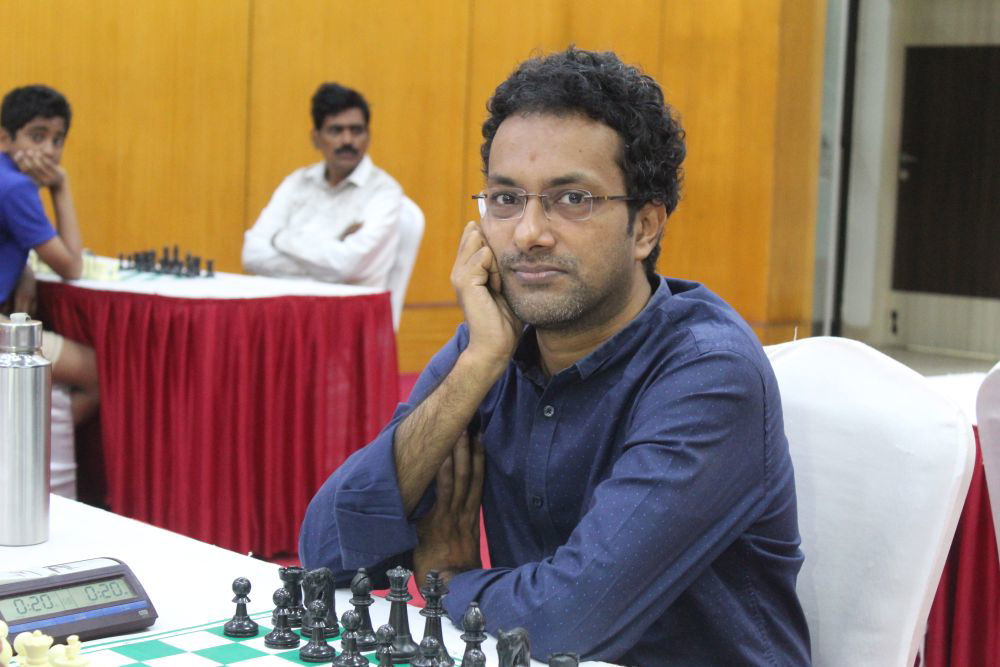
ChessBase India is happy to see GM Sundararajan Kidambi writing his first post of the year 2023 in his blog "Musings on Chess". Knowing what an encyclopedic knowledge the grandmaster from Chennai possesses, I think we are in for a treat! One can only hope that Kidambi continues writing regularly! We will keep reminding him about it! We are awaiting to read his next post of the year 2023 and be enriched.
Links
The article was edited by Shahid Ahmed





































